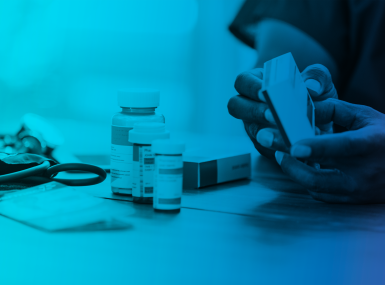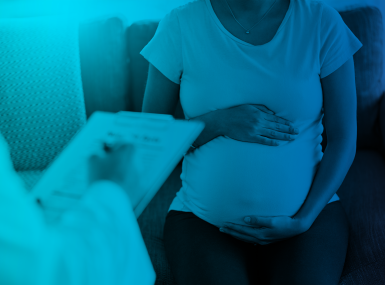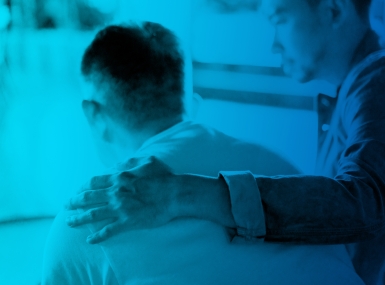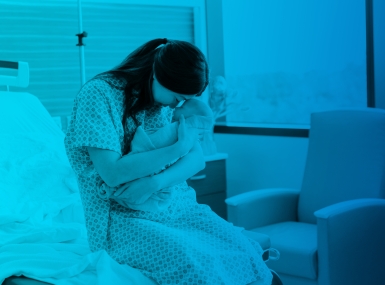Treatment and Recovery for Pregnant and Parenting People

Upcoming Events
Related News
Jump to Section |
What is effective treatment for opioid use disorder for pregnant and parenting people?
During pregnancy, the evidence-based standard of care for opioid use disorder (OUD) is treatment with methadone or buprenorphine. These medications for opioid use disorder (MOUD) are safe to use during pregnancy and recommended by the U.S. Substance Abuse and Mental Health Services Administration (SAMSHA),2 the American Society for Addiction Medicine (ASAM)3 and the American College of Obstetricians and Gynecologists (ACOG).4
Even though MOUD is the standard of care, many pregnant and parenting people cannot access MOUD through existing healthcare infrastructures.5,6 In addition, pregnant and parenting people with OUD may avoid the healthcare system out of justified concerns about child welfare involvement and the risk of losing their children.7–10 Child removal is associated with a greater risk of accidental overdose for the birth parent11 and entry into the foster system is associated with worse outcomes for the child.12
Effective treatment for pregnant and parenting people means expanding access to MOUD and adopting a family-centered approach that prioritizes keeping families together.13,14
“Rather than discouraging discussions of drug use during pregnancy, we should be looking upon them as an opportunity to bring about positive, long-lasting change in the life of the [parent] and child, through effective treatment and support services.”
-Loretta Finnegan MD1
Eat, Sleep, Console
Watch a short video about Eat, Sleep, Console: a family-centered program for parents and newborns affected by substance use.
What evidence supports treatment with MOUD for pregnant and parenting people?
Methadone and buprenorphine have been used to treat OUD for decades; research consistently supports their effectiveness.15,16 For people with OUD, receiving these medications during pregnancy improves delivery outcomes17 and reduces the risk of non-fatal overdose by as much as 97%.18
Treating OUD with naltrexone during pregnancy is widely discouraged by medical experts.2,3,4 Only two of the three FDA-approved MOUD are recommended during pregnancy: methadone and buprenorphine.
Attempted abstinence during pregnancy—whether through medically-assisted detoxification or at-home efforts to quit “cold turkey”— has an 85-90% failure rate.19,20 It can also increase the risk of overdose, cause fetal distress and precipitate pre-term labor.3
Treatment during pregnancy with methadone or buprenorphine does not increase the risk of neonatal abstinence syndrome (NAS), sometimes called neonatal opioid withdrawal syndrome (NOWS). Receiving higher doses of either medication does not increase the severity or duration of NAS symptoms.21,22 Even if it does occur, NAS is a short-term, manageable condition.23,24
Are there risks to my community or institution if we don’t support treatment with MOUD for pregnant and parenting people?
Yes.
Approximately 1 in 20 pregnant people use drugs,25 meaning roughly 200,000 infants are born each year exposed to substances. The need for evidence-based treatment and recovery support for pregnant and parenting people is great, but access to MOUD is extremely poor—especially for Black and Hispanic persons of reproductive age26,27 and in regions most affected by opioid use and overdose.5 Poor MOUD access for pregnant and parenting people may result in higher social and healthcare costs for managing substance-affected pregnancies.28,29
Further, the Americans with Disabilities Act (ADA) offers protections to people who are receiving treatment for a substance use disorder. Discrimination against persons receiving MOUD treatment—including pregnant and parenting people—is considered a violation of the ADA and could be grounds for legal action.30
What are best practices to support treatment and recovery for pregnant and parenting people?
- As your state laws allow, develop a template for Plans of Safe Care for use by relevant child welfare agencies providing care for substance-affected pregnancies in your county in accordance with the Child Abuse and Prevention Treatment Act of 2016 (CAPTA). Plan of Safe Care templates help coordinate better support for families impacted by substance use and reduce unnecessary engagement with child welfare services.31
- Help secure funds to cover the cost of medications for pregnant and parenting people who may lose access to health coverage (including Medicaid) shortly after giving birth.32–34
- Support access to MOUD in rural or underserved areas by promoting telehealth,35 mobile clinics36 and other innovative approaches to serve pregnant and parenting people.37
- Expand free and affordable family housing options for pregnant and parenting people receiving treatment for OUD.14
- Fight stigma and misinformation by voicing strong support for MOUD as an evidence-based treatment for OUD during and after pregnancy. Stigma and misinformation about OUD and MOUD pose significant and persistent barriers to people getting the care they need.38
What are some examples of successful treatment and recovery programs for pregnant and parenting people?
Project CARA (Care that Advocates Respect/Resilience/Recovery for All) is a program of the Mountain Area Health Education Center, which serves pregnant people with substance use disorders in 20 western, Appalachian counties in North Carolina. Project CARA provides trauma-informed perinatal healthcare that includes MOUD treatment alongside wraparound services to address housing, transportation, food security and other social determinants of health.39
The Pregnancy Recovery Center at the University of Pittsburgh’s Magee-Women’s Hospital offers MOUD to pregnant people through patient-centered delivery of care. The Pregnancy Recovery Center care team consists of obstetric and gynecological physicians who are licensed to prescribe buprenorphine, a nurse with addiction medicine training and a social worker.40
The Maternal Opiate Medical Support (MOMS) initiative in Ohio offers MOUD to people living with OUD both during and after pregnancy through a medical care home model. MOMS also provides access to residential treatment—when residential care is indicated—that allow parents and children up to 12 years of age to continue living together.41
These and many other model programs are described online at the Brandeis Opioid Resource Connector
Additional Resources
Where can I learn more about treatment and recovery for pregnant and parenting people and improving treatment access for these persons in my community?
- Centers for Disease Control and Prevention, “Linking People with Opioid Use Disorder to Medication Treatment: A Technical Package of Policies, Programs, and Practices”
- National Perinatal Association, “NPA Position Statement on Perinatal Substance Use”
- Office of the Assistant Secretary for Planning and Evaluation, “State Policy Levers for Expanding Family-Centered Medication-Assisted Treatment"
- National Advocates for Pregnant Women, “Issue Brief – Parenting and Drug Use”
- National Center on Substance Abuse and Child Welfare, "Building Community Support to Prevent Family Involvement in the Child Welfare System” (webinar)
- National Center on Substance Abuse and Child Welfare, “How States Serve Infants and their Families Affected by Prenatal Substance Exposure"
- National Institute on Drug Abuse (NIDA) Director Dr. Nora D. Volkow, "Pregnant people with substance use disorders need treatment, not criminalization"
- National Perinatal Association, infographics on substance use during pregnancy
- National Advocates for Pregnant Women, “Understanding Opioid Use During Pregnancy”
- The Academy of Perinatal Harm Reduction, “Pregnancy and Substance Use: A Harm Reduction Toolkit"
Where can I find support or technical assistance for scaling up treatment and recovery for pregnant and parenting people?
National Network of Perinatal Quality Collaboratives (PQCs)
PQCs consist of state-wide or multi-state networks providing resources and expertise to improve perinatal and infant health outcomes, including reducing pre-term birth, reducing racial/ethnic and geographic disparities in treatment and treatment outcomes, and improving care provided for NAS. A directory of all nation-wide PQCs can be found on the National Institute for Children’s Health Quality website.
Opioid Response Network (ORN)
The ORN is a technical assistance collaboration between the American Academy of Addiction Psychiatry and Columbia University. The ORN has local consultants in all 50 states and 9 U.S. territories to provide communities with technical assistance and education on the prevention and treatment of OUD.
Rural Health Information Hub (RHIhub)
RHIhub hosts a comprehensive series of online training modules and toolkits to support community leaders and healthcare practitioners in better understanding proven and available treatment strategies for pregnant and parenting people with OUD.
The Academy of Perinatal Harm Reduction (APHR):
APHR provides free educational resources for healthcare providers and pregnant patients on effective, evidence-based perinatal care in the context of substance use. APHR also offers trainings on evidence-based care of pregnant and parenting people who use drugs for healthcare professionals, social workers, lawyers and judges, community advocates and more.
Rural Communities Opioid Response Program – Technical Assistance (RCORP-TA)
RCORP-TA is a multi-year initiative by the Health Resources and Services Administration (HRSA) that offers numerous online technical assistance resources, including many on the topic of improving treatment and treatment access for pregnant and parenting people..
Author
Jennifer J. Carroll, PhD, MPH







